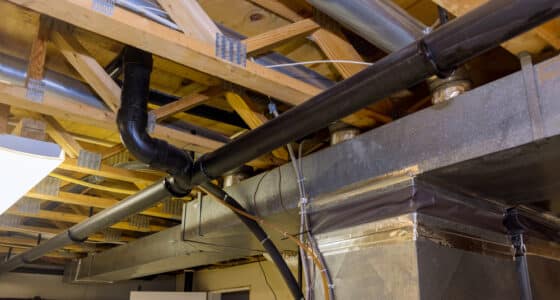Asbestos is commonly found in the ductwork of forced air heating systems installed between the 1950s and 1980s. The material was used to seal air gaps where the ductwork joints met and to insulate the equipment. Exposure to asbestos-wrapped and insulated ducts can lead to malignant mesothelioma, asbestosis, lung cancer, and other serious diseases.

Why Was Asbestos Used in Ductwork?
Ductwork is responsible for distributing heated or cooled air throughout a building as part of an HVAC system. In addition to its primary functions of air circulation, air supply, air return, and air quality maintenance, well-sealed and insulated ductwork improves HVAC efficiency and reduces utility costs.[1]
Because of its characteristic strength and its heat, fire, and sound resistance, asbestos was a valued component of materials used to wrap and insulate ductwork between the 1950s and the 1980s, when it was identified as carcinogenic.
Because asbestos materials were used so commonly during these years, much of the ductwork that exists in residential, commercial, and industrial spaces today continues to present a risk of asbestos exposure.
There is a particular risk on the inner and outer walls of heating ducts and from a cloth made with asbestos used to cover air handler vibration dampers. Transite cement, a type of asbestos-containing cement, was also used around heating ducts.[2]
Why Is Asbestos in Ductwork Dangerous?
Asbestos is a known carcinogen. When asbestos tape and wrapping materials are damaged, they release microscopic fibers into the air, where they can spread throughout the environment.
The materials located inside ductwork are particularly dangerous, as these particles can be circulated through airflow, landing on surfaces, or being inhaled. Asbestos fibers are odorless, tasteless, and microscopic, so they pose a hidden threat.
Once asbestos fibers enter the body, they can become embedded in tissue and begin to cause significant damage, including scarring and inflammation.
There is a particular danger when asbestos is trapped in the cells of the mesothelium, an organ that lines the cavities that hold the pleural and peritoneal organs. These mutations can grow into deadly tumors.
Illnesses associated with asbestos exposure include:
- Malignant mesothelioma – A rare, aggressive cancer affecting the lining of the lungs or abdomen.
- Lung Cancer – A deadly malignancy linked to asbestos exposure.
- Asbestosis – A chronic lung disease caused by asbestos fiber scarring.
There is no cure for any of these conditions, and they are often associated with a poor prognosis and significantly reduced life expectancy.
Who Is at Risk of Asbestos Exposure from Ductwork?
Asbestos exposure from asbestos-containing materials used in ductwork represents both a past and present danger. Workers who manufactured and installed the materials, as well as those who have maintained or removed asbestos-wrapped ductwork since the time of its installation or worked near this ductwork, all face significant risk:
- Heating, ventilation, and air conditioning (HVAC) contractors
- Insulators
- Plumbers
- Maintenance workers
- Construction workers
- Factory workers
- Millwrights
- Engineers
- Boiler workers
- Demolition workers
- Firefighters
There is also the risk of secondary asbestos exposure for the family members of any of these workers. Homeowners and residents living in homes built before the 1980s are also at risk. This is especially true of those who do their own home repairs or renovations that may disturb ductwork that contains asbestos materials.
Types of Asbestos Materials Used in Ductwork
Asbestos-containing materials were applied a the elbows and joints of ductwork, where separate ducts met. The goal was to prevent air from escaping and improve the efficiency of ductwork. Asbestos-containing materials were also used to prevent fires.
The different asbestos materials used in ductwork included:[3]
- Duct Tape. The joint sealant tape that was used in heating ducts before the 1980s contained 35-65% chrysotile asbestos. Unlike modern duct tape, it was thicker, with a fibrous, cloth-and-plaster appearance in white or gray colors. While intact tape may not release fibers, it’s easily damaged – even peeling can release asbestos.
- Paper Insulation. Asbestos paper insulation was applied wet to ductwork for secure adhesion when dry. It is typically found on the exterior of older ductwork but is sometimes hidden on the interior, making it much harder to identify since doing so requires removing the register supply or return grills for inspection.
- Vibration Dampening Cloth. Vibration dampeners (dampers) between air handlers and metal ductwork are used to reduce operational noise. While most dampeners installed today use rubber materials, older units were made of asbestos cloth that contained high concentrations of chrysotile asbestos. These appeared white, gray, or silver (if aluminum-coated) and, when damaged, could release asbestos fibers.
- Asbestos Cement. In some older homes, the ductwork itself was made from asbestos cement. This material was also used as gas venting for appliances such as furnaces, boilers, and water heaters. A clear indicator of asbestos cement is its rough, fibrous edges when cut, and if the cement deteriorates within the ducts, asbestos fibers may be released into the home’s air.
How to Avoid Asbestos Exposure from Ductwork
If you are a homeowner or manager of a structure that was built before the 1980s, there is a very good chance that its ductwork includes asbestos-containing materials. The only way to know for sure if you have asbestos in a building is with professional testing.
If asbestos materials are in good condition, you can leave them alone. Follow these precautionary measures to protect the health and safety of everyone in the building:
- Avoid touching, bumping, or disturbing the asbestos-containing material.
- Minimize the time spent in any area where asbestos is present.
- Never try to peel off asbestos tape or wrapping.
- Don’t cut, puncture, drill, or scrape the material, as this can release dangerous asbestos fibers.
- If replacing or modifying ductwork, hire a professional asbestos abatement company first so that they can safely remove the asbestos material before work begins.
- Schedule periodic inspections of your ductwork to monitor the condition of the material.
Asbestos materials that are friable, or crumbling, are extremely dangerous and pose the risk of releasing hazardous fibers into the air. Asbestos-containing duct tape or insulation should be removed if it has sagged or collapsed.
However, if the material is intact and undamaged, encapsulation may be the safest and most cost-effective option.
Encapsulation can also be a viable solution if asbestos insulation is located inside the ductwork or if the ductwork itself is made of asbestos cement. This work should only be done by a licensed asbestos abatement company to prevent exposure risks.
Companies with a History of Exposing Workers to Asbestos-Containing Duct Material
The following companies manufactured or supplied asbestos-containing products that were used in ductwork:
- Albany International Corp.
- A.O. Smith
- Burnham Pump Company
- Dunham Bush, Inc.
- Duro-Dyne
- H.B. Smith Company
- Johns Manville
- W.R. Grace Corporation
- Rich Tex Inc.
- Georgia-Pacific
- Celotex
- Grant Wilson
- H.B. Fuller
- Nicolet
- Owens Corning
- Turner & Newall
How to Protect Yourself from Workplace Exposure to Asbestos-Containing Ductwork Materials
If you are in a profession that puts you at risk for exposure to asbestos-containing ductwork, the Occupational Safety and Health Administration (OSHA) has imposed comprehensive regulations to ensure workplace asbestos safety. These strict rules include specific exposure limits and required safety protocols.
Know your rights as a worker to a safe workplace. Learn the regulations and workplace safety procedures, and hold your employer accountable to them.
Always use any safety equipment that’s provided to you as directed, and if you have concerns about asbestos exposure at work, discuss them with your employer. If they fail to correct the situation or take appropriate safety measures, you can file a complaint with OSHA or contact your union representative or industry-specific organization for help.[4]
Have You Been Diagnosed with Mesothelioma or Another Asbestos-Related Condition?
If you’ve been diagnosed with mesothelioma or another asbestos-related illness following exposure to asbestos-containing ductwork materials, getting specialized medical care as quickly as possible is crucial.
Early intervention and expert care are vital. Numerous studies have found that patients diagnosed with malignant mesothelioma see significantly better outcomes when they are treated at academic medical centers, which offer:
- Specialists who treat a higher volume of these cases and who have greater expertise
- Multidisciplinary teams of medical oncologists, radiation oncologists, surgeons, pathologists, and other specialists whose members have deeper experience in recognizing complications early and managing complex symptoms
- Surgeons who perform cancer operations more frequently typically have better outcomes.
- Regular tumor board meetings where multiple experts review and plan each patient’s care
- Integrated supportive services like nutrition, physical therapy, pain management, and psychological support
- Advanced technology and treatments
- Latest diagnostic tools and imaging equipment for more accurate staging and monitoring
- Access to state-of-the-art treatment facilities, techniques, and specialized equipment like proton therapy or robotic surgery platforms
- Research and clinical trials
- Dedicated patient navigators to coordinate care
- Social workers to help with practical and emotional needs
- Integrative medicine options like acupuncture or massage
- Support groups and counseling services
- Financial counselors to help with insurance and costs
Compensation for Those Sickened by Asbestos in Ductwork
If you’ve been diagnosed with mesothelioma or another asbestos-related disease, you may be eligible to seek compensation from the companies that made asbestos ductwork.
Whether your exposure was occupational or as a homeowner, an experienced mesothelioma lawyer can provide you with the information you need about your rights and options.
The possibilities include filing a personal injury lawsuit, filing a claim against an asbestos trust fund, or filing a claim with the Department of Veterans Affairs if you are a veteran and your exposure came as a result of your service.
References
- Lennox. (n.d.). Ductwork.
Retrieved from: https://www.lennox.com/residential/buyers-guide/guide-to-hvac/glossary/ductwork - Asbestos123.com. (n.d.). Guide to Identify Asbestos-Containing Products in Your Home.
Retrieved from: https://www.asbestos123.com - IndoorScience. (2021, February 12.). Asbestos in Ductwork.
Retrieved from: https://indoorscience.com/blog/asbestos-in-ductwork/ - Occupational Safety and Health Administration. (n.d.). Asbestos.
Retrieved from: https://www.osha.gov/asbestos

Terri Heimann Oppenheimer
WriterTerri Oppenheimer has been writing about mesothelioma and asbestos topics for over ten years. She has a degree in English from the College of William and Mary. Terri’s experience as the head writer of our Mesothelioma.net news blog gives her a wealth of knowledge which she brings to all Mesothelioma.net articles she authors.

Dave Foster
Page EditorDave has been a mesothelioma Patient Advocate for over 10 years. He consistently attends all major national and international mesothelioma meetings. In doing so, he is able to stay on top of the latest treatments, clinical trials, and research results. He also personally meets with mesothelioma patients and their families and connects them with the best medical specialists and legal representatives available.


